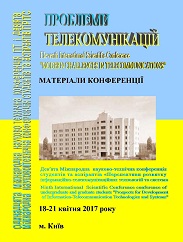MODELLING OF COMMUNICATION SYSTEMS WITH IMPULSE-RADIO ULTRA-WIDE BAND SIGNALS
Анотація
Моделювання систем зв’язку, що
використовують імпульсні надширокосмугові сигнали
Представлено імітаційну модель найпростішої системи зв’язку, що використовує імпульсні надширокосмугові (IR-UWB) сигнали. Модель реалізує метод неенергетичного прийому імпульсів. При цьому застосовано найпростіший метод канального кодування із пасивним нулем.
Посилання
‘Non Energy’ Reception of Ultra Short Impulse Signals / Sergey Bunin, Institute of Tetelecommunications of the National Technical University of Ukraine “KPI”, Ukraine, 2010, 4 p.
Giordano, А. А. Modeling of Digital Communication Systems Using SIMULINK / Giordano А. А, Levesque А. Н. - М.: John Wiley & Sons, 215. —
Why UWB? A Review of Ultrawideband Technology / Leonard E. Miller Institute of Wireless Communication Technologies Group National Institute of Standards and Technology Gaithersburg, Maryland, 2003, 78 p. - ISBN 978-1-118-40005-0
Nekoogar, Faranak. Ultrawideband Communications: Fundamentals and Applications // Prentice Hall, USA. 2005 – 240 pp.
##submission.downloads##
Як цитувати
Номер
Розділ
Ліцензія
Авторське право (c) 2017 Сергій Олександрович Михайлов, Сергій Георгійович Бунін, Ігор Володимирович Трубаров

Ця робота ліцензується відповідно до Creative Commons Attribution 4.0 International License.
Authors who submit to this conference agree to the following terms:a) Authors retain copyright over their work, while allowing the conference to place this unpublished work under a Creative Commons Attribution License, which allows others to freely access, use, and share the work, with an acknowledgement of the work's authorship and its initial presentation at this conference.
b) Authors are able to waive the terms of the CC license and enter into separate, additional contractual arrangements for the non-exclusive distribution and subsequent publication of this work (e.g., publish a revised version in a journal, post it to an institutional repository or publish it in a book), with an acknowledgement of its initial presentation at this conference.
c) In addition, authors are encouraged to post and share their work online (e.g., in institutional repositories or on their website) at any point before and after the conference.

